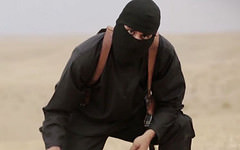ISIS Superstar: The New Media Jihad

The infamous ISIS is currently one of the world’s greatest concerns. The Jihadist group and self-proclaimed Caliphate stands as a multifaceted threat to democracy, human rights and religious peace. J.M Berger, an analyst of extremism and its use of media, has declared ISIS “the most aggressive invading force in the Levant since the Mongols”[1]. Indeed, ISIS is fighting in the name of a religion that it has interpreted for itself, in an extremely radical and strict manner. Nonetheless, there lies a discrepancy between its aim at re-instating a backwards society as they believe that it existed more than fourteen centuries ago, and its artful and supremely efficient use of modern media.
ISIS is not only the embodiment of the West’s worst fears in this age of Islamophobia and growing terrorist threats, but it has also been rejected and deemed too radical by its own mother branch that is Al Qaeda. How has a splinter group from Al Qaeda gained such momentum that it has stolen the limelight from other jihadist groups? One of the possible answers to this question is ISIS’s mastering of multiple social media platforms. Since the first appearance of their black flag and the proclamation of the Caliphate in June 2014, we have watched ISIS’s “victories” and actions behind our screens with both fear and incredulity.

Propaganda has been extensively used throughout history by different types of governments, both radical and moderate, in order to bolster public support, usually by playing on fear and using popular images and references to reach out to the greater public. Joseph Goebbels, the Reich Minister of Propaganda under Hitler, led Nazi control over all aspects of German culture, through the use of radio, the press and visual arts. In today’s shrinking global village, the spread of information has been made all the easier by the extensive use of social media. Now back to today’s issue: ISIS. They claim to strive for a new world Caliphate under which their own Salafist interpretation of sharia law would be exclusive. However, the young age of most of the jihadi fighters means they are well versed in the use of modern technology and modes of expression.
One of ISIS’s first groundbreaking video releases was that of a young fighter proclaiming “Sykes-Picot is dead!”calling for the annihilation of all international frontiers. ISIS not only has various Facebook accounts and over 45,000 Twitter accounts[2] controlled by some of its recruits, it has also created a Twitter app for Android Phones called “The Dawn of Glad Tidings”[3]. After requiring entering personal information (and thus building up a data base) the app provides users with flash news and regular updates on the Islamic State’s activities. It is believed that thousands of fighters are spreading the group’s message through social media[4]. J.M.Berger states: “This is a combination of an extremely ambitious military campaign with an extremely ambitious PR campaign. Social media is most of that PR campaign. Big corporations wish they were as good as ISIS is at this[5].”
Not only does ISIS use social media to spread its ideology and make its violent actions known to the world, it has also increasingly used popular images and references in favor of their propaganda. For example, they have reportedly altered the popular acronym “YOLO” (You Only Live Once) often used as a hashtag on Facebook, Instagram or Twitter, to “YODO” as in “You Only Die Once” followed by the caption “Why not make it martyrdom”.
It seems that these young jihadists, who are most likely running the show, have been fed on the culture of violence advertised by Hollywood movies and video games. The culture of epic warfare violence they promote offers ISIS an array of possible inspirational ground. For example, they have used the video game “Call of Duty” as a base for their own propaganda blockbusters: “This is our Call of Duty, and we respond in Jannah” (paradise). These posters thus advertise the professionally shot videos that follow, capturing aerial shots and rampaging fighters. ISIS has also allegedly created recruitment videos in which they have incorporated footage of “Grand Theft Auto”, in which they confirm: “your games which are produced from you, we do the same in the battlefields!”[6]
ISIS even has its star fighters. The four main jihadists that appear in the videos of the beheadings of James Foley, David Sotloff, David Haines and Allan Henning, have been named “The Beatles” due to their British accents and origins. Their lead fighter, commonly known as Jihadi John, has attracted much attention. Indeed, his mysterious persona has stood out, either due to his western origins, or the need for the public to put a face on the perpetrators of these inhumane acts of violence which are justified in the name of religion.

This type of messaging has created an increasing appeal to ISIS in the eyes of young westerners that are disenchanted with the cultures they live in, which may result in their adoption of radical ideas. These young men and women are often born as second or third generation immigrants. While having grown up in a western country, sharing the same culture and national identity as their peers, they may still feel a kind of estrangement as they continue to be considered “strangers” due to their religious or cultural backgrounds. This faction of the population is therefore an “easy” target for ideological groups such as ISIS, which claims to offer a better and more glorious life.The ISIS phenomenon relies highly on its eschatological approach, using the appeal of a unified Muslim world, after the Muslim community has been torn and split for centuries over sectarian and spiritual differences. The Caliphate appears as a promising beacon of hope for populations that feel abandoned, cheated on, and have nothing left to lose.
There have been recent instances in which young western men and women have left their country of origin to join the jihadist group in Syria, as many as 500 from the UK alone. A recent scandal revolved around the recruitment of three young London girls, aged fifteen and sixteen, who left unexpectedly for Syria, not unlike the twenty other young women from the UK in the last year[7].
Furthermore, through their extensive use of media, ISIS has created a new culture of fear across the globe; giving the constant impression of their perceived success that somewhat blows the reality of their actions out of proportion. We are constantly reminded of their actions and their “victories” in either conquering territory or committing atrocities. As the war-zones from which they operate from are of difficult access for the international press, we are found grappling for a clearer view of the “reality” on the ground. In lieu of reports, the international media also perpetuates ISIS’s yearning for attention by diffusing their atrocious video clips and photos. ISIS therefore manipulates the West’s media tools, just as it has done with its weapons, by using western media as a platform for PR and followers [8].
ISIS’s aim at bringing the populations under its control back in time is inherently flawed, as the fighters cannot escape modernity which imprinted on them, which is manifested in their increasing use of technology. They have indeed been able to use it in a way that has both horrified public opinion and romanticized their cause in the eyes of the vulnerable and marginalized. The issue today relies in western government’s willingness to develop strategies in counter-acting this “media jihad” movement, and their making it a top priority if they wish to stop seeing inflows of western fighters join the ranks of the Islamic State.
[1] Berger, J.M. “The Islamic State vs. Al Qaeda.” Foreign Policy. N.p., 2 Sept. 2014. Web. 14 Nov. 2014.
[2] http://www.themetropolitain.ca/articles/view/1498
[3] http://english.alarabiya.net/en/media/digital/2014/06/24/How-has-ISIS-conquered-social-media-.html
[4] Berger, J.M. “The Islamic State vs. Al Qaeda.” Foreign Policy. N.p., 2 Sept. 2014. Web. 14 Nov. 2014.
[5] CBS news
[6] http://www.dailymail.co.uk/news/article-2765414/Isis-use-video-game-Grand-Theft-Auto-5-recruit-children-radicalise-vulnerable.html
[7] http://www.independent.co.uk/news/uk/home-news/syria-girls-at-least-60-british-women-and-girls-as-young-as-15-have-joined-isis-in-syria-10078069.html
[8] http://www.theguardian.com/world/2014/oct/07/isis-media-machine-propaganda-war
